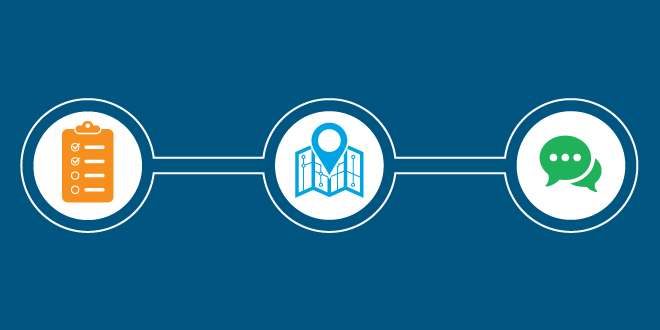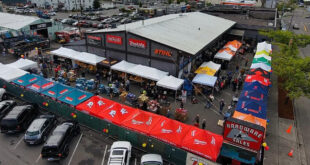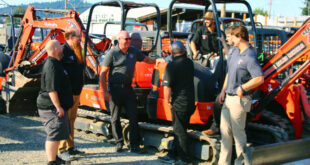To view a PDF of this story, click here and read a Q&A from another retailer who has different strategies for going to markets.
By: Liz Lichtenberger llichtenberger@nrha.org , Jesse Carleton jcarleton@nrha.org and Sara Logel slogel@nrha.org.
If you’re like the typical home improvement retailer, at least twice a year, you will pack your bags and head off to your distributor’s buying market.
It’s time to stock up on inventory, network with fellow retailers, attend an educational seminar or two and look for some of the latest products your customers will be wanting.
But have you ever wondered if you are making the most of your time at the market? You have a lot to pack into two or three days, and it’s easy to feel overwhelmed once you hit the show floor. It’s even easier to get overwhelmed as you think about how you should prepare for and wrap up after the show.
So, how do you go to market?
It’s much more than visiting a different city and strolling the market floor, buying some things here
and there and chatting with a few people you see only twice a year.
Instead, you should try to plan well in the weeks, or even months, leading up to your distributor’s buying market, and follow up with employees or vendors once you’re back in your store after the market.
The editors at Hardware Retailing reached out to three long-time market goers who have well-planned steps they take before, during and after a buying market. While everyone’s process is a little different, learning what other retailers do may give you some ideas of how you can improve in your own processes.
Read on to learn more—you may find some ideas you want to implement during your next show.
And after you read, click here for a Q&A with one retailer who provides us a complete rundown of how she works a market, from beginning to end.
Before
The market may be weeks or even months away, but there’s still plenty to do to prepare ahead of time.
What Are Your Goals?
Retailers go to buying markets for different reasons. Before you start thinking about how to prepare, it’s important to determine what your goals are. Goals can vary by retailer, or the same retailer’s goals can vary by market, so it’s important to take some time to determine what you really want to accomplish at the show before you start making plans.
“The main goal for us is to buy inventory,” says Hilario Serrano, director of marketing and advertising at Randall Lumber and Hardware in Taos, New Mexico. “While we focus on inventory, we also look at new programs our distributor has to offer, new incentives and anything that will work well in our marketplace.”
Once you know what your goals are you can start thinking about who you’ll bring with you to the market and what your budget will be, among other things.
Who’s Going?
One of the first things you need to do is determine how many of your employees to bring. If you have too few, you risk not getting everything done, but you also have to consider the expense of sending staff to the market.
Tim Post, owner of T&M Hardware with six locations throughout Pennsylvania, has gone to almost every Do it Best market for the past 25 years.
During spring markets, which are in the beginning of the store’s busy time, Post attends the markets with his wife, Mary, co-owner, and daughter Samantha, manager of marketing and human resources, along with Will Hogue, operations and purchasing manager. During fall markets, he brings a team of eight or nine, including each store manager and his son, Scott, the sales and rental manager.
Steve Spradlin, owner of Lake Isabella Hardware and Builders Mart True Value, both located in Lake Isabella, California, takes a different approach. He and his wife are usually the only two from his business to attend the True Value Reunion. (If the market is within a day’s drive, he might take an employee or two.)
For Randall Lumber and Hardware, both Serrano and his hardware manager, Russell Driskell, attend Blish-Mize and Orgill markets, along with their wives.
Following a Budget
The retailers we spoke with suggested coming to market with a budget already in place, or at least some guidelines on how much you want to spend.
Post sets guidelines, rather than a strict budget. “We are so focused on buying out of the warehouse that we generally never have a problem with budgeting,” he says. “We try to limit the impulse buying that we do at the market, but if it makes sense to buy, then we do. We will stay within budget if we adhere to our guidelines.”
Keep in mind that just because buying markets generally have good deals doesn’t mean every item you see is automatically a deal. A guideline Post sets is that if there is 15 percent or less in savings on an item, his team moves on. High-ticket items are viewed differently, however, as a small percent can lead to big-dollar savings.
Besides promotional buying, Post also takes advantage of replenishment or pre-season buying if the opportunity presents itself.
“We tend to order salt, shovels and sleds at the spring market or other seasonal buys that are present,” Post says. “We also do commodity and bulk item buys as well. In the spring, we order pallet goods or commodity items because a few pennies on that can make us more competitive.”
Serrano does not have a strict budget either, but he has a good gauge of what his team is going to buy at the market ahead of time.
“The reason we don’t set a budget is because a lot of times last-minute orders are determined from the spiffs we get back from vendors and the travel allowances we receive,” he says. “We really utilize market incentives.”
New retailers may want to be a bit more structured in their buying. “If you’re a new store owner, it’s a good idea to have a budget of how much you’re going to spend,” Spradlin says, “because you could be tempted by way too many things and end up spending more than you should.”
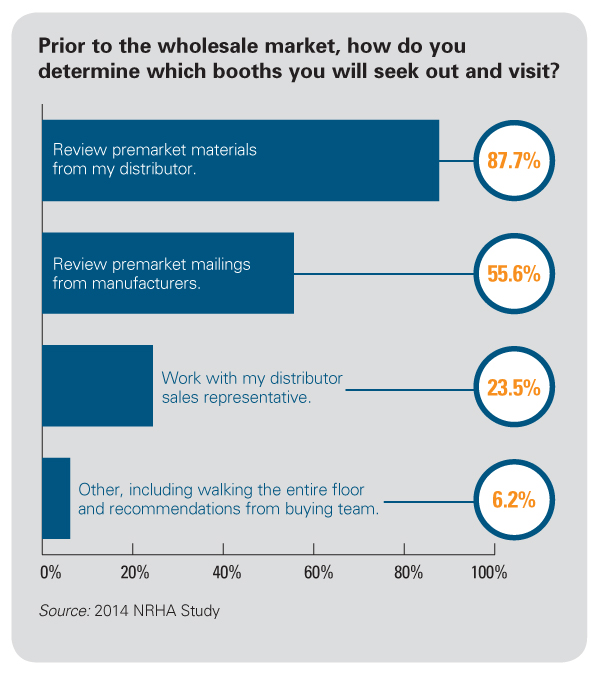
Prep Time
Market prep is an ongoing, year-round project. However, as you get closer to market time, you’ll need to finalize your plans.
Post meets with his team 30 days before the market. During this time, the store managers or personnel who are attending summarize what they will focus on once they get there.
“I ask them to boil their lists down to 12 items,” Post says. “I feel that if during the two and a half days we are at the market, they focus on getting 12 things accomplished, it will serve them very well. It’s a nice manageable number.”
The 12 items on the lists vary with each market but could include things like Do it Best’s Education Day, which includes a full day of seminars; the Sneak Peek of the show floor on Friday night; scheduling meetings with Do it Best vendors or even gathering more information on new government regulations, says Post.
For Spradlin, the official preparation for the buying market starts when he receives premarket material from his co-op. He gets both the printed and electronic versions, and he uses both.
The process is time-consuming, he says, because it’s important to review all of the material so as not to miss anything. He’ll scan the market books, looking for discounts or new items he would like to investigate further once he’s there.
“Throughout the year, we make a list of what around the store needs refreshed,” Spradlin says. “It’s an ongoing process. We always go to market with certain items in mind from areas around the store that need upgrading. Of course we always find those unexpected items, but we always go with a specific list in mind.”
He also makes a plan for how he’ll work the market ahead of time so that he finishes everything on his to-do list. Given the size of most markets, it’s impossible to visit every booth and talk to every vendor, so he makes a schedule with benchmarks of what he wants accomplished each day.
“Map out what you want to have accomplished by noon on the first day, then where you should be by the end of the first day,” he says. “There will be a lot of optional things to do and see, but it’s important to prioritize what’s necessary and what’s optional.”
According to a 2014 study from the North American Retail Hardware Association (NRHA), the majority of retailers, like Spradlin, use premarket materials from their distributors to determine which booths they’ll visit.
Serrano and his team begin market preparation about 60 days in advance. To prepare, his team holds off on large orders and does a store walkthrough in departments he knows he will sell out of in the next six months.
“If I know I need to make a large purchase, I hold off until I can get market pricing and dating or cash incentives at the booths,” he says.
In addition, Serrano uses the premarket book from his distributor that includes SKUs he has purchased at prior markets.
“It gives us projections on future sales in the coming months,” he says. “It’s a great tool that gives us educated information.”
During
Now that you’ve made your plans for what you’re going to accomplish at the market, it’s time to put that plan into action.
Hitting the Showfloor
Serrano hits the showfloor according to a pre-determined plan. He uses the market layout map to highlight booths his team needs to visit.
“We visit those booths with an order in hand that we will issue,” he says. He then records all of these orders and booth numbers in his market planner.
It’s a good idea to keep a list of current inventory with you so that if you find a new product you’re interested in, you can refer to the list and see if it would be a good purchase.
Serrano uses his distributor’s app to get information about his account and the quantities he’s ordered over different months.
“We also bring a tablet or laptop,” he says. “I remote in to my office computer so I can see quantities at the store and price levels over the past months.”
Since carrying around a laptop at markets can be cumbersome, Serrano uses a mini shopping cart, where he creates a mobile work station. This work station includes his laptop, scissors, stapler, shelving, market literature and an accordion file book to organize market and purchase orders.
Post and his wife stay through the end of the buying market on Monday, whereas most of his team leaves on Sunday afternoon. On Monday, he takes advantage of a quieter market floor and returns to vendors for further discussions.
Spradlin works the market floor every day and hour it’s open. When it’s over, he and his wife spend a lot of time doing follow-up paperwork in the hotel room.
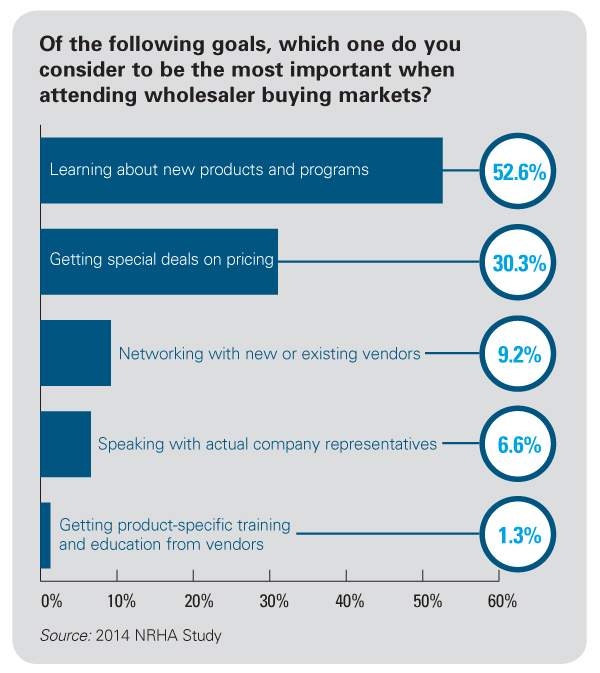
Staying in Touch
If you bring a larger team to the market, make sure you stay in touch with everyone to ensure all work is being completed. While you don’t want to micromanage (and probably don’t have time to do so), it’s important to touch base occasionally with the rest of the group.
Every two to three hours, Post meets with his team to review their lists and see progress. After attending seminars, for example, Post gathers with his team and asks each member to share a takeaway they can implement to grow either professionally or personally.
Enjoying Some Down Time
Once you finish up on the market floor, take advantage of your time away from work to relax.
Post and his team sometimes attend Do it Best’s evening activity, but otherwise they get dinner with staff or other retailers.
If Serrano attends a distributor market in a city where he has never been, he tries to come in a few days before the market begins to spend some time and explore.
After
You’ve accomplished all your market tasks and it’s time to head back to your business. But your work isn’t finished yet—it’s time to wrap up things at home.
Bringing the Market Excitement Home
As soon as T&M Hardware’s team leaves the buying market, they immediately begin making plans to implement new strategies.
As Post and his team make the six-hour drive home, they write a follow-up list of what they accomplished at the market and prioritize how they will implement different items once they return.
“We do 75 percent of that within the first 48 hours of returning,” he says. “We have to be right on top of it when we come back and get things in motion.”
Spradlin finds it’s easy to let the excitement of the market begin to fade as soon as he walks off the market floor, but to prevent this, “We start thinking about the next market about the time we get back from one,” he says.
Because it’s easy to get caught up in work as soon as you return to your store (and especially since you’ve been away a few days), try making a list of things to do when you get back, as Post and his team do. In fact, you can keep a running list going as you walk the market floor.
Putting everything on paper will keep those items front of mind and help you take care of that list as soon as you return. Try, if you can, to avoid immersing yourself into your work at the store and returning to “business as usual” right away. Instead, use your first day or two back as “market wrap-up” and focus on completing those post-market items.
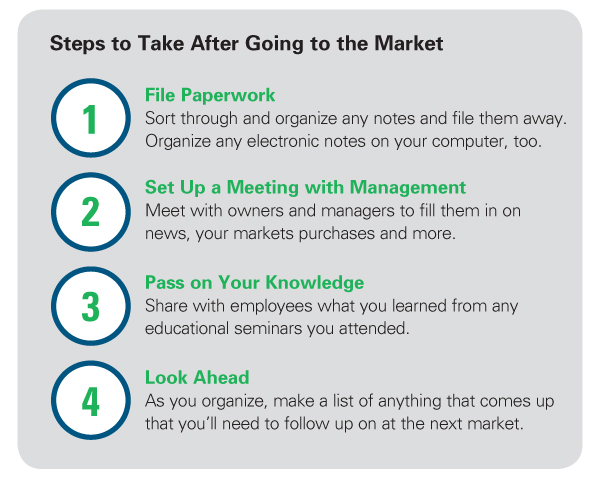
Sharing What You Learned
One of the most important tasks to take care of when you get back after the buying market is touching base with employees who didn’t attend.
Spradlin says there’s a lot of value in sharing the information and inspiration found at the market with the staff that wasn’t able to attend.
To be able to share the information with employees, Spradlin takes photos of new products at markets on his iPad.
To ensure Serrano’s staff is up-to-date when he returns from the market, he, along with Driskell, his hardware manager, and the store’s owners meet to discuss new initiatives they want to implement. Then Serrano meets with department heads to share what new items are coming in and which ones are going away. He later meets with the receiving department to inform them of orders to expect in the coming weeks or months.
Post has a meeting with store managers as soon as he returns, and the managers then have meetings with their stores to update the staff on areas of opportunities generated from the market.
After updating the staff and implementing immediate changes, the planning continues.
“We keep a list of items at each market that we do not need to address right now but will readdress at the next market,” he says. “If customers ask about different products, we write those down. We continuously have a list we can cross items off of and keep moving forward.”
 Hardware Retailing The Industry's Source for Insights and Information
Hardware Retailing The Industry's Source for Insights and Information



